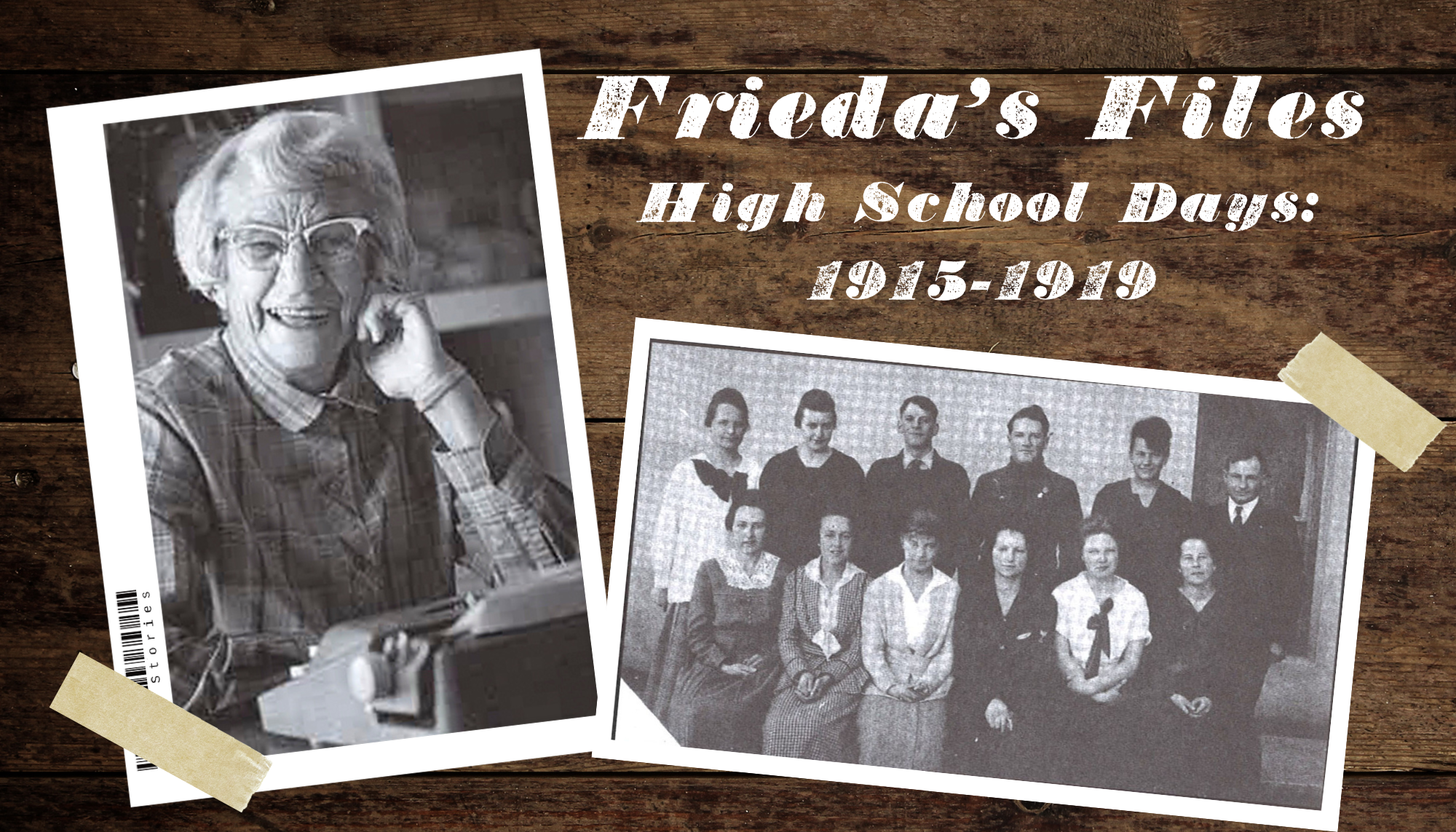Frieda’s Files are a collection of historical short stories about Carson Valley by Frieda Cordes Godecke, published in The Record-Courier. Reproduced here with permission from the Cordes Cousins, and their book “Frieda’s Files”.
Rip-Saw, Buzz-Saw,
Cross-Cut, Bang!
We belong to
The Douglas Gang!
This may sound a bit corny now, but I can assure you more loyal hearts never beat than did those within the bosoms of the 1915-1919 students of Douglas County High.
This writer entered Douglas High in Sept. 1915 after completing the eight grades in the one room schoolhouse in Centerville. Our class, which numbered 23, was the largest class to ever enter Douglas High School. This number dwindled to 12 upon graduation in 1919, but it was still the largest class in the school’s history to graduate.
Thirty-plus students made up the student body in 1915, increasing to around 60 by 1919. These students and their three teachers occupied the upper floor of the old schoolhouse which was located at the end of Gillman Ave. where the Chuck Meneley home now stands. The lower floor was occupied by the Gardnerville Grammar School.
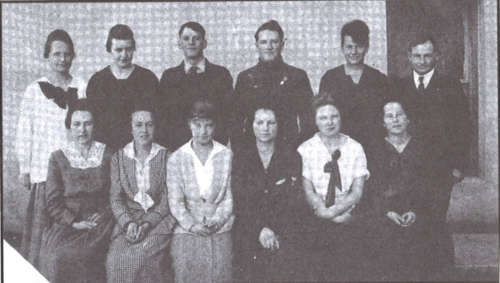
The 1918 senior class. Back row (left to right) are Elda Fricke, Edna Hellwinkel, Lloyd Springmeyer, Norman Brown, Frieda Godecke and T.S. Hook, principal. Front row (left to right) are Ramona Brockless, Clara Imelli, Alvina Hussman, Evelyn Pedroli, Grace Jepsen and Dorothea Neddenriep. Not shown is Emma Schacht. (Photo from the Frieda Godecke collection.)
The new high school, at the time one of the finest in the state and which is now the middle school, was ready for occupancy at the first of the year in 1916. Under the capable leadership of Principal T.S. Hook, we were proud to begin the second semester of our freshman year in the new building. How good it felt to no longer be crowded for space! And what joy it was to have a gym in which to play basketball!
That gym served a two-fold purpose. It was also the student body assembly hall. It mattered not that each time it was to be used as a gym, the seats which were fastened to one another by four runners, had to be shoved into the entrance hall. There was always willing hands to take care of this detail.
We were proud, too, of our tennis court since much of the hard labor that went into its building was furnished by high school students.
Buses to and from school were unheard of. You found your own mode of travel. During our freshman year we made our way from Centerville with horse and wagon, stabling the horse at Jepsen’s Livery Stable across the street from the old school. During our second year we rode as a paying passenger with Arthur Springmeyer, and the last two years we occupied the back seat of Ott Hansen’s trusty Ford. Sometimes this Ford traveled a bit faster over the rough and bumpy roads than was necessary, raising us into the air from our seats. We never seemed to worry. The back seat was always there when we came down again.
Lunch containers of all descriptions lined the hall. They varied from tobacco and lard buckets to store-bought lunch pails. Many problems were discussed over these lunch pails on the front steps of the school building during the noon hour. During our last two years we had the privilege to add one hot dish to our cold lunch. This was provided by the domestic science class at 10 cents a serving.
Domestic science was not taught until 1916 when Willamina Richards, one of our faithful teachers, took over that responsibility. The previous year our other much-admired teacher Cora Krueger met with girls in their homes on Saturdays to instruct them in cooking and baking, and in teaching them to crochet, tat, and knit. This was all done on her own without pay.
Miss Krueger was also our German teacher and an excellent one. When the door was closed on the second year German class, not another word of English was spoken. Questions and comments were all made in German. Toward the end of the year, the class put on a German program which proved to be very interesting to the many German people in the Valley.
Miss Stella Van Dyke was head of the German class when war with Germany broke out, and teaching of the language was prohibited. About this same time L. Ross Johnson joined the teaching staff and took over agriculture and commercial subjects.
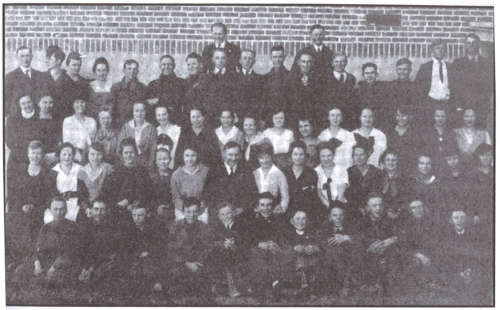
Douglas County High School student body, 1919. (Photo from Frieda Godecke collection.)
Douglas has always excelled in athletics, and the teen years were no exception. Two state championships were annexed during those years—the first in 1914 and the second in 1915. Since that time Douglas has never failed to make a fine showing in all competition.
The girls as well as the boys took great pride in their basketball teams. This writer had the pleasure of being on the girl’s team the four years she attended D.C.H.S and remembers well the thrill it was to come out on the floor looking glamorous in our black serge bloomers, white middies, and orange mesh caps. Loyal rooters joined in singing “The Orange and the Black” and in our booster-upper—“Boom, boom, how the ocean waves are rolling; Boom, boom there’ll be weeping on the sea; for we always had a habit of scoring; And for us it means another victory , Rah, Rah!; So, you’d better take your life preservers with you: Boom, boom, for a storm is sure to brew; Through a Douglas gale no ship can sail; Boom, boom, our team is after you!”
We remember, too, the enthusiasm we felt as we boarded the little “Yellow Canary” at the Minden depot for our games away from home. The “Canary” was originally a white bus but was repainted a bright yellow, and its regular wheels were replaced by railroad wheels. It ran on the railroad tracks and comfortably carried both boys and girls teams to and from the Valley. Sometimes it balked a bit when it sighted Lake View Hill. The stalwart boys on board were ready and willing to give it a boost up the steep grade.
We looked forward especially to our game at Virginia City. Here, as on other trips, we spend the night as guests in the homes of our opponents. We feel privileged to have been one of those who took the trip into the bottoms of the earth to view the process of ore mining in one of the large Virginia City mines. Only three of the girls were brave enough to make the trip. This tour was considered dangerous and was closed to the public soon after.
Drugs, smoking, and drinking at D.C.H.S were no problem. They just weren’t done.
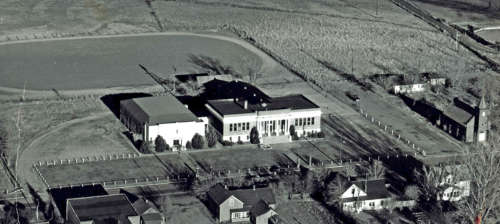
Aerial view of Douglas County High School, 1946.
We seemed to find other ways to get our kicks. Sometimes they did not meet with the approval of our teachers and were justly punished. We recall one beautiful spring day when over our lunch pails we discussed the interesting things to be seen at the circus in Carson City. When one of the boys said his Ford was at our disposal, five of us put our lunches aside, hopped into the Ford, and headed for Carson City. The circus was as much fun as we had anticipated, but the next day at school was not so pleasant. After a severe lecture on playing hooky, Mr. Hook said we would have to make up after school, the four hours we had been away from the premises. How long it took for us to do that was up to us. This punishment was not too severe on those who lived nearby, but those of us who lived three or four miles out in the country lost our rides home and were forced to walk that distance. One of the culprits sat out his entire four hours in one evening, keeping the teacher there until 8 p.m. She probably suffered more than he did.
Our senior year was upon us before we realized, and then came the last days when school ties are broken forever. Our thoughts go back to the night of the “Prom”. Attired in a tan silk dress and high, bronze button shoes, we made merry with our classmates. Formal dress was not necessary. A dinner had been prepared in the domestic science rooms to honor the class of 1919 and was served by the junior class. The teachers and school board members were special guests. Some members of our class were called upon to give short talks on various topics, and I was asked to do a reading entitled “The One-legged Goose”. I had rehearsed until I knew the reading backward and forward, and yet when I arose and floundered through the first few lines, my mind went completely blank. I stumbled and sputtered until I had my audience so confused they weren’t sure the goose I was talking about had one leg or a dozen.
Then came our graduation evening. There were no caps and gowns in those days. We sat on the stage and listened to what some state official thought it was right for a graduating class to hear and then received our diplomas from Mr. William Lampe, board president. The exercises concluded with the “Indian Love Call”, beautifully sung by Mrs. F.H. Dangberg, a member of the board.
And so—“When the cares of life oe’rtake us, mingling fast our locks with grey, Should our dearest hopes betray us, false fortune fall away; Still we banish care and sadness as we turn our memories back, And recall those days of gladness ‘neath the ‘Orange and the Back.”’
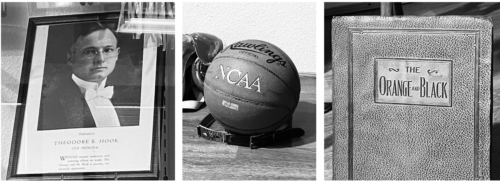
You can come and see the D.C.H.S display and walk the halls of the school at the Carson Valley Museum and Cultural Center!



